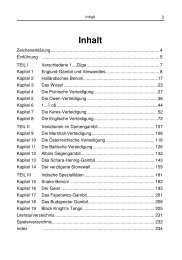Knight on the Left - Schachverlag Kania
Knight on the Left - Schachverlag Kania
Knight on the Left - Schachverlag Kania
You also want an ePaper? Increase the reach of your titles
YUMPU automatically turns print PDFs into web optimized ePapers that Google loves.
198<br />
a) 6. g3 c6 7.a3 f6 8.d3 h5! 9.<br />
g5 h4! 10. xh4 xe4 11.dxe4 xh4<br />
12. d3?!, Brat-Zita, CSSR (ch) Prague<br />
1953, 12... e5 13. b5+ e7 followed<br />
by ... xe4. In my opini<strong>on</strong>, White has not<br />
enough compensati<strong>on</strong>.<br />
b) 6.d3 c6 7. g3 a5 (7...g6 8.h4,<br />
7... f6 8.f4) 8. b5+ d7 9. xd7+ xd7<br />
10. f3 c6 11.0-0 f6 12. h3 d6<br />
13.c3 e5 14. xd7+ xd7 15.cxd4 cxd4,<br />
Ardeleanu-Lupu, Romania (ch) 1996. A<br />
typical King’s Indian endgame with colours<br />
reversed, however, White already exchanged<br />
his bad bishop, approx. .<br />
c) 6.b4!? (6.e5!?) 6...cxb4 7. b2 c6<br />
8. d3 c5 9. f3 e5?! (else 10. exd4)<br />
10. xf7+! xf7 11. c4+ Goldman (at<br />
<strong>the</strong> end Black’s positi<strong>on</strong> is not as bad as<br />
it looks).<br />
5.e5!<br />
5. ce2!? e5 as in Van Geet Attack with<br />
<strong>the</strong> queen in play.<br />
5...dxc3<br />
5... g4 6. d3! Goldman.<br />
5... bd7!? is a weird idea that results in<br />
some compensati<strong>on</strong> for a pawn after<br />
6.exf6 e5 7. xf7+ xf7 8.fxg7 xg7<br />
9. e4 d3 (Gypla-Solya, corr. 2003) or<br />
7. e2 xc4 8.fxg7 xg7 9. xc4 e6<br />
followed by dxc3.<br />
6.exf6<br />
Now <strong>the</strong> questi<strong>on</strong> for Black is whe<strong>the</strong>r to<br />
Chapter IV<br />
accept a slightly inferior positi<strong>on</strong> (doubled<br />
pawns) or to grab a ‘hot’ pawn.<br />
6...cxd2+?!<br />
Besides:<br />
a) 6...cxb2? 7. xf7+! xf7? (7... d7<br />
8. xb2 exf6 , first happened in T.Schiller-<br />
G.Kuhn, Pinneberg 2001) 8.fxg7+ xg7<br />
9. xb2+ g8 10. g3+ f7 11. xh8<br />
1-0, Dieu-N. N., Tours 1993.<br />
b) 6...gxf6 7.dxc3 d7 8. f4 with<br />
some initiative for White, Shamkovich-<br />
N.Kopylov, Chigorin memorial 1951.<br />
White may insist <strong>on</strong> gambit play by<br />
7. h5!? cxd2+ (7...e6 8.dxc3 is a slight<br />
improvement <strong>on</strong> 7.dxc3) 8. xd2 e6 9.<br />
f3 (9.0-0-0 d4!?, Eraclides-Y.Kotov,<br />
corr. 2002).<br />
c) 6...exf6<br />
The most solid move - White keeps <strong>the</strong><br />
advantage of <strong>the</strong> first player but nothing<br />
more.<br />
7. xc3<br />
7.dxc3 and 7.bxc3 are equally good - a<br />
matter of taste.<br />
7... d6 8. e3+<br />
Or 8. f3 e7+ 9. e3.<br />
8... e7 9. f3<br />
9.d4 e6 10. d3 0-0 11. e2 d7 12.<br />
0-0 fe8, Lipnitzky-Goldberg, Baku 1951,<br />
according to Negele. Devotees of <strong>the</strong><br />
Caro-Kann with 4...exf6 might protest<br />
and ra<strong>the</strong>r call this a standard positi<strong>on</strong>.<br />
9... e6 10. b3 xb3 11.axb3 xe3+<br />
12.fxe3,



